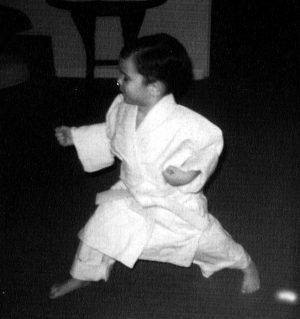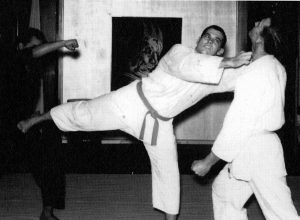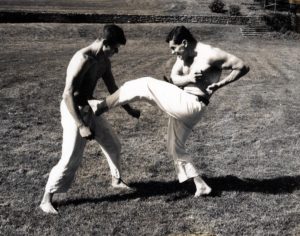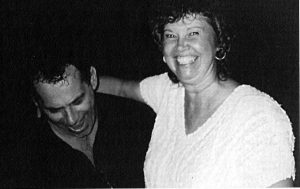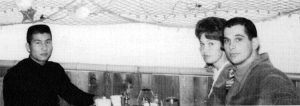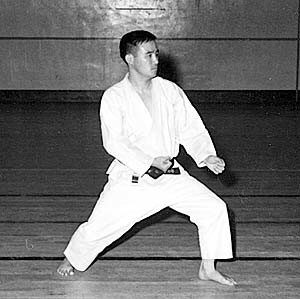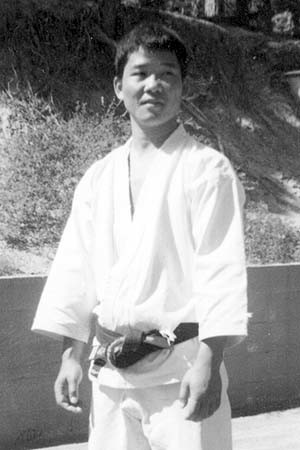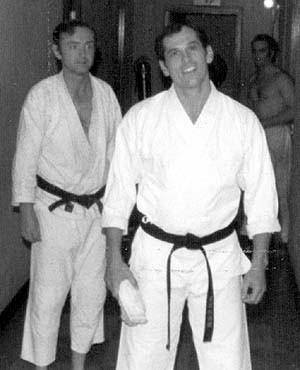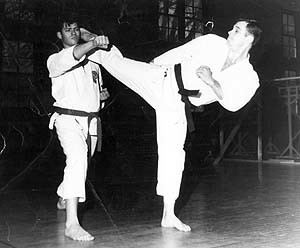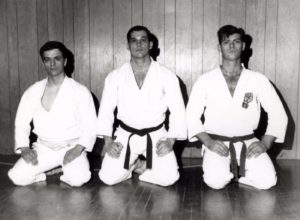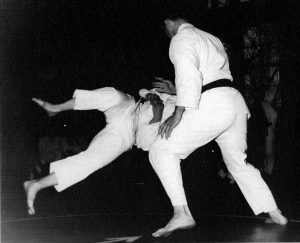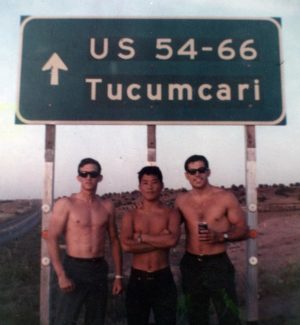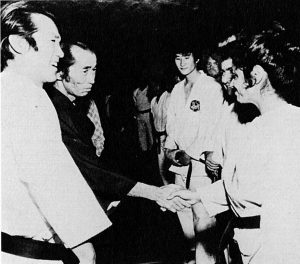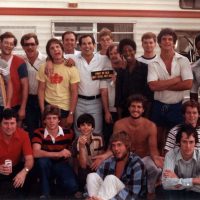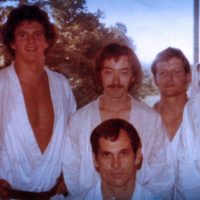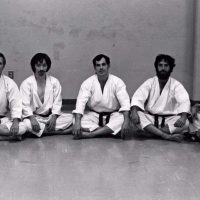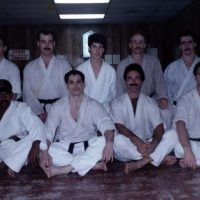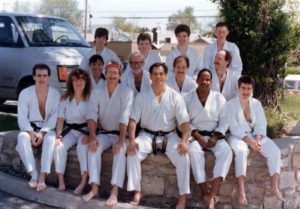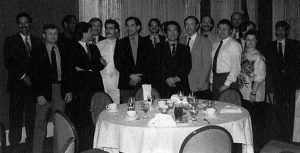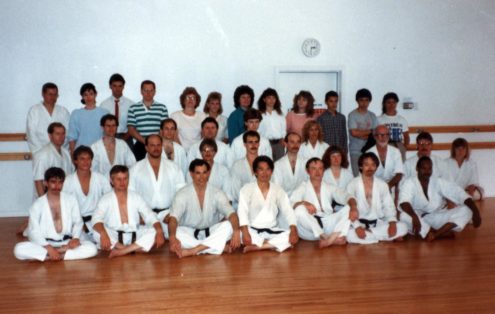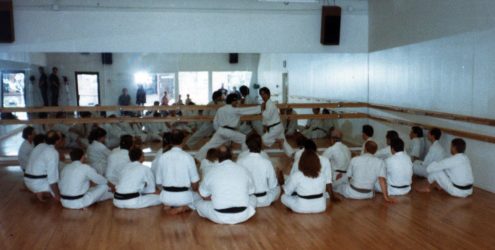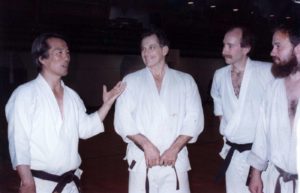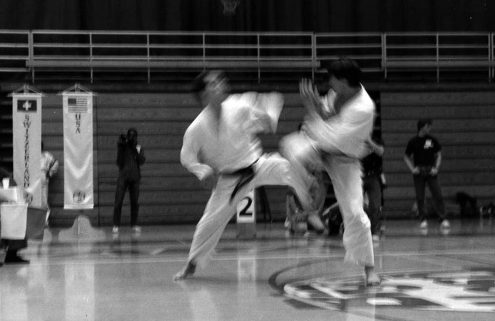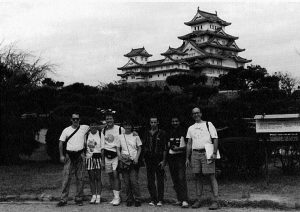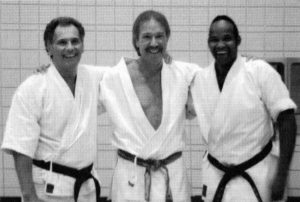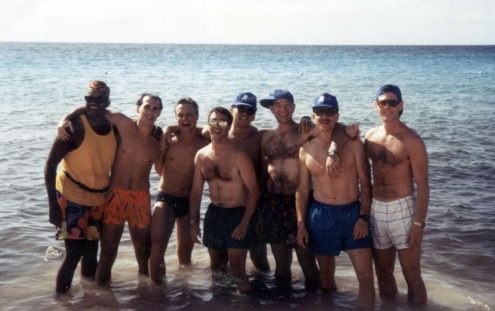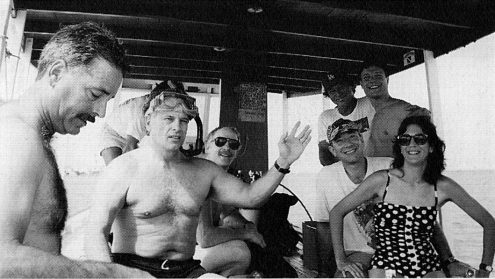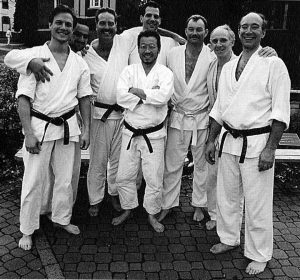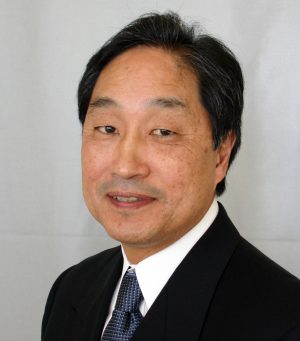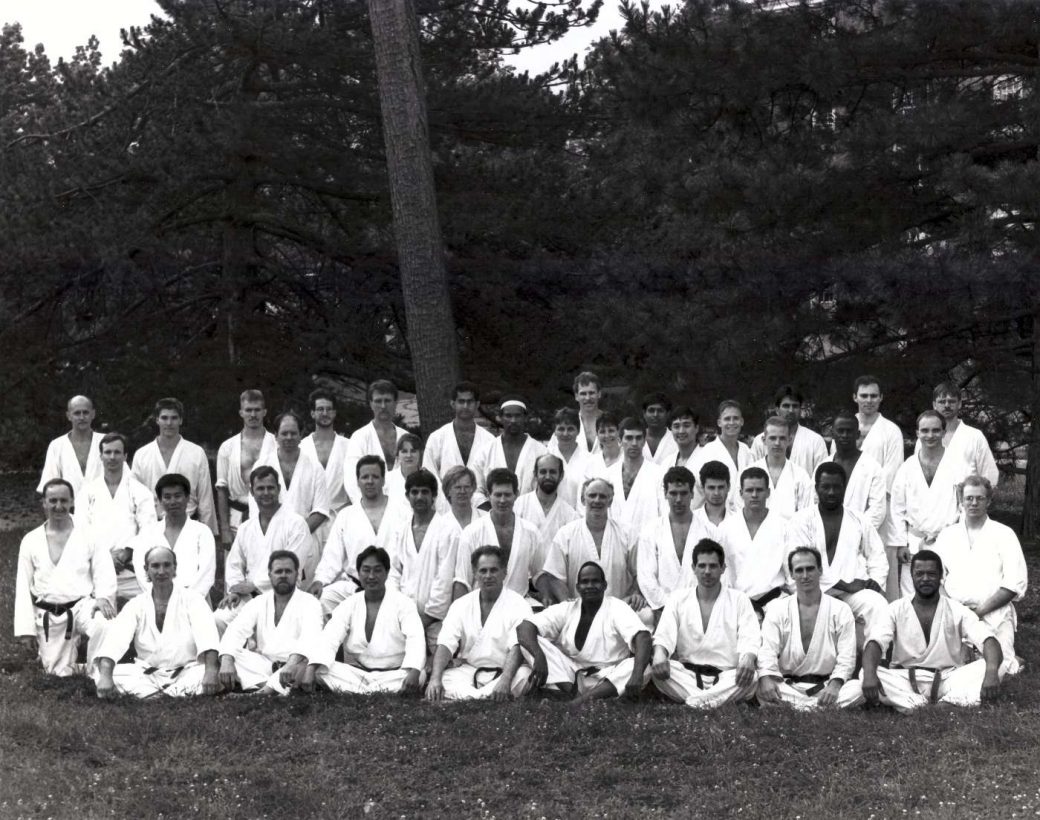by Mike Lyon, manager
All quotes taken from interviews with Jon Beltram (abbridged to remove material inappropriate to public)
The story of how Shotokan Karate came to Kansas City is largely unknown to most of us practicing today. Shotokan Karate owes its existence to Master Gichin Funakoshi and his teachers, Master Azato and Master ltosu. Shotokan Karate of America was started by one of Master Funakoshi’s students, Tsutomu Ohshima in 1956. Ohshima Sensei and his juniors made several visits to Kansas City in the mid-1960’s. Jon Beltram had been practicing a number of martial arts since 1959, and was teaching a kind of amalgamation of various techniques. When he was introduced to Mr. Ohshima’s style of Shotokan Karate he was inspired. He has made Shotokan his exclusive practice for thirty years. Hundreds have practiced with him. Forty-one have attained black belt level. He has led Kansas City Shotokan since its inception in 1966.
It was because of Jon’s dedication and hard work that the practice took root here and grew. Today, there are six Shotokan dojos in the area, one led by Jon, and five led by his juniors. The stories of the origin of Shotokan Karate in Japan and the United States are well told elsewhere (see Karate-do Kyohan and Karate, My Way of Life by Gichin Funakoshi, and the SKA 20th and 30th anniversary albums for more information). This is the story of Shotokan Karate in Kansas City.
Jon Beltram was born in Lexington, Missouri on July 10, 1941. He was the youngest child in his family with three older sisters. His parents passed away within a short time of one another in 1988 and 1989. Jon’s mother had been a housewife most of her life, and his father, having earned both an MD and a DO, practiced medicine for fifty-five years.
Jon was a talented athlete at Lexington High School and president of the Thespian Society. He played four years of high school basketball, football, track, played baseball every summer and boxed in the winter time. It was during his senior year that Jon first encountered a kind of karate.
“I was a high school senior in 1959, boxing at a military school in my home town. They had the facilities, ring, and the gear, and I would box there. They had a Korean ‘tac’ officer, Mr. H. T. Song, a Tae-Kwon-Do guy, there who watched me box and asked me one day if I’d like to spar with him. I was very pompous, and I thought he was too little for me and that I would hurt him. He was one of those Korean rock marines who were coming over at that time to help in military schools with tactics, military technique and that type of thing. Finally, I agreed to spar with him, and I tried to hit him several times. He just kind of side stepped, so I charged him and tried to hit him, and he side stepped and kicked me in the head. That was the first time in my life that I can ever remember in a fisticuffs kind of situation that I was knocked clear off my feet. I’ve been studying karate ever since.
“I was 17 then. It was my senior year, but I was a year younger than most of the other seniors. I was so amazed at his foot speed. It had never entered my mind that the feet could do that. The only feet I’d ever seen were very slow and cumbersome and very ineffective. It was very interesting to me. I practiced with Mr. Song for about eighteen months. I was getting ready to go to college when I started. I’d wanted to go to the University of Missouri, but wound up going to Missouri Valley which was closer to home so I could continue to study with him.”
In college, Jon was starting quarterback for four years. He feels that it was his college football career which was responsible not only for the two knee surgeries he had at the time, but also the nine knee surgeries, five hip surgeries (including three complete hip replacements) and several back surgeries he underwent later in life. Jon worked his way through college as a bouncer in Kansas City, Lexington, Richmond, and Warrensburg, Missouri where he gained a lot of real combat experience.
“Some of the places I worked were high class, some weren’t. I worked at the Holiday Inn several years while I was working on my masters degree and teaching, and it was pretty nice. Before that, I worked places like The Swinging Shed, Roadhouse 410, the Top Hat. Places you wouldn’t want your son or daughter to visit. I have lots of scars from the Swinging Shed. I worked there two years, and it was a real bad place. We had lots of trouble every night. I had a guy attack me with a hatchet one Thursday night. I was shot in the hand while I was taking a gun away from a person there. I had multiple-opponent conflicts. Lots of times I just took a bo and waded into people to break up the serious fights.”
In spite of his dangerous employment, Jon managed to marry Bobbie in 1962, still his wife thirty-four years later, and to graduate in 1964 with a BS degree in Education.
“It’s amazing that a woman of my wife’s character has spent that long with me. She’s been a great asset to me. We have two wonderful children. My son, Kent, is twenty-eight, and my daughter, Elise, is twenty-three, both college graduates, both very good citizens.”
After receiving his undergraduate degree, Jon began working as a foreman at the General Motors plant in Kansas City. He was also getting paid to teach four to five classes a week at the Kansas City Academy of Judo and Karate at 39th and Main. The academy was owned by Dr. Richard Yennie. From 1964 until he left the Academy in 1969,
Jon was introduced to and practiced under some of the best karate men in the world. He spent two years practicing JKA Shotokan under Mr. Mikami, three time champion of Japan. Two years of Goju-ryu under Gosei Yamaguchi, the son of Japanese Goju leader Gogen Yamaguchi. At the same time, two years under Shoichi Yamamoto, a sixth dan student of Toguchi, head of the Goju school in Okinawa. Another year or so of Tae-Kwon-Do with Jang Yul Park, one of Mr. Song’s juniors. Also, Shorin-ryu and Okinawan Kempo under Mel Wise. And Judo under Wei Sing Kim. Jon had been awarded dan certificates in Tae-Kwon-Do, JKA style Shotokan Karate, Okinawan Goju-ryu, Japanese Gojuryu, and Judo.
Jon was active in the martial arts tournament circuit between 1965 and 1970. He competed in three or four major tournaments per year all over the country. His life and practice were not without risk. Altogether, he suffered twenty-seven broken bones, was shot, stabbed, and underwent numerous surgeries. He was extremely competitive, refused to give up under any circumstance, had a strong sense of fair play and a hot temper.
“I was in a tournament in ’65 or ’66 in Phoenix, Arizona, and a guy named Jim Hawkes and I were fighting for the championship. We were fighting, and I hit him with a reverse punch. Immediately after my reverse punch, they gave me a point, and he hit me in the nose and just shattered it. Bone was sticking through the skin. The referee came up to me and asked me if I wanted to continue, and I said ‘yeah.’ And he asked me if I could continue, and I said ‘yeah.’ And he said, ‘This really looks pretty bad; we’re going to have to have the doctor look at this.’ And I said ‘yeah.’ So the doctor eventually said I could fight. So when they said ‘Hajime,’ I just rushed him, grabbed him, and beat him in the head and the face, and the referee was trying to get me off him, and I was disqualified, of course. Today our control is a little better.”
Jon had seen Mr. Ohshima once, in 1964 or 1965, when Mr. Ohshima was in Kansas City to give a brief demonstration. After that visit, Jon asked Dr. Yennie to invite someone from Mr. Ohshima’s group to Kansas City to teach. Mr. Ohshima sent his junior, Mamoru Ohara to Kansas City in 1966.
“Mr. Ohara came to Kansas City to give practices at the Academy on his way to teach at the University of Illinois at Champaign/Urbana. I was teaching judo and karate, and I got to meet and practice with Mr. Ohara. When Mr. Ohara came, he stayed only for a very brief period of time. But it was like he opened a door for me. I finally saw what I felt was the essence of real karate. Strong hard practices. Strong spirit. Tremendous focus and concentration. Brutal, if you look at it one way, but unequivocally very formidable and very usable karate.
“Pretty soon after meeting Mr. Ohara, I asked him if he did jiyu-kumite. He said, ‘Of course, my favorite!’ So I asked him if he’d spar with me. ‘No,’ he replied. ‘Why not?,’ I asked him. ‘Because, I would kill you!’
“Mr. Ohara was aloof but very strong. Very tough. Very strong. Hours and hours in practices which you just couldn’t believe. We’d be exhausted and just practice more, practice more, practice more. Not a big man physically, but a very strong guy.
“Somebody once asked him if size made a difference in fighting, and Mr. Ohara replied, ‘Of course! The bigger the better!’
“I remember something about Mr. Ohara which really impressed me in 1966. We were doing tekki-shodan, a very small kata. During the movement to the side, he somehow stomped on his own toe and took off his big toe-nail and the top of his toe. The bone was showing and he was bleeding profusely. He behaved as if nothing had happened. After we finished our kata practice, we did jiyu-kumite. Everyone was covered with blood from his kicks. We all thought he’d be unable to practice for a long time, but he never missed a single one. He didn’t even put a Band-Aid on it –just pulled on his socks and shoes and went about his business.”
In early 1967, Mr. Ohara moved to the University of Illinois. Jon had been so impressed with Mr. Ohara that he insisted Dr. Yennie invite someone else from Mr. Ohshima’s group. Mr. Ohshima sent Mr. Shoji Okabe, a sandan at the time. Mr. Okabe had graduated from Waseda University in Tokyo in 1963. He had been vice-captain of the karate team there.
“Mr. Okabe was very friendly and open. He constantly wanted to talk. We’d go out to eat and do things together. We became close friends quickly, but mostly he became a leader to me and taught me many things.
“Mr. Okabe was friendly, but he was a very tough guy! When I first started practicing with Mr. Okabe, we were having a kumite match, and it turned into a Donnybrook. I mean we were on the floor just like a real fight. He blacked both my eyes, cut my nose, and bloodied my lip.
“Mr. Okabe is like a brother to me. Even though for years we haven’t had a lot of contact, I will always think of him as someone very important to me and very close to me.”
In 1967, while Mr. Okabe was in Kansas City, Jon actually met and for the first time, got to know Mr. Ohshima a little.
“Mr. Ohshima came to visit, and I was just amazed. I’d been around a lot of pretty well known karate people. Mas Oyama, Gogen Yamaguchi, and others. I was never that impressed with any of them.
“But when Mr Ohshima came to Kansas City, I was impressed the minute I saw him -his eyes -his posture -the way he moved -the way he held himself-and especially the way he fought! I couldn’t understand why the other guys at the Academy didn’t pick up on it. He fought Okabe in a demonstration, and it was amazing. Okabe threw a round-house kick, and Mr. Ohshima became very small, went between Okabe’s legs, and punched Okabe in the head. I had never seen anything like it. He had unbelievable technical skill. I mean he was amazing. He was the best I’ve ever seen.”
Mr. Okabe stayed in Kansas City, teaching at the Kansas City Academy for about six months late in 1967. Then he moved to the University of Illinois. Jon and Okabe stayed in contact, continued their friendship, and had several exchange practices. Jon met Jim Kaplafka during one of those exchange practices.
“The very first time I set eyes on Jim Kaplafka was at a 1968 exchange practice at the University of Illinois. We both were nidan. Mr. Ohshima had just made me nidan in the fall, and this was spring. We went up, and Mr. Honda was there from Pittsburgh with his group. Mr. Okabe was there, and Mr. Ohshima was there. The first time I saw Jim was when he walked up after Mr. Ohshima asked us to face each other in jiyu-kumite. I looked at Jim and thought he wasn’t a very tough guy, but was I surprised! He attacked me furiously. I wasn’t used to being attacked, and he came at me with both barrels. It kind of changed the way I thought about kumite for a long time afterwards. He was a very spirited and strong guy. Over the years, Jim has become… well, like family. We’re all a big family.”
Jon attended his first special training in 1968 at Lake Arrowhead, California. Jon remembers it as a terrible hardship and an awful shock, but it wasn’t all bad.
“The most important thing Mr. Okabe introduced me to was special training, which I believe is the essence of our style. It is where the uniqueness and difference in our system lie.
“After about six months in Kansas City, during 1967, Mr. Okabe moved to the University of Illinois. We stayed in contact, had exchange practices, and in 1968 he invited me to go to summer special training with him. He said it would be wonderful. We’d go up into the mountains in a beautiful setting and practice and eat good food, and he planted in my mind that this would be a resort type setting.
“It was the biggest shock of my life. I’d been through all kinds of athletic training, harsh football three-a-day training, but I was not prepared for what the special training actually was. It was very difficult. We were running barefoot in the mountains. Even though they were not very big mountains, I was having trouble breathing. During the practices I felt like I was gasping for air. And the practices were just incessant. Just one after another and long and hard. No let up.
“There were maybe fifty people at that special training. Black belts slept in cabins, two to a bed, five or six to a cabin. Mr. Ohshima led the training. We all cleaned up, but the wives of the seniors did all the cooking. Mr. Ohshima’s wife, Caylor Adkins’ wife, Mr. Honda’s wife cooked for us all. Can you imagine?
“And we sometimes had strange practices. I remember Mr. Ohshima put us in this huge open field at night in 1968 and 1969 at Arrowhead. There was no moon. He just lined us up and said ‘Hajime!’ We had open kumite in the night -everybody against everybody, a free for all in the darkness. I don’t know whether it was the level of the students, but many people were cut and injured. Lots of just furious emotional encounters. It was a very exciting time.
“The practices were only a little different then from now, but the running was VERY different. We would run up the mountain to a school about two and a half miles, and then run back down after practice. We did that two times a day. At night we didn’t run, because Mr. Ohshima said it was too dangerous, so we drove to night practices. But the trainings were much more intense, and there was much more yelling and screaming by Mr. Ohshima and the seniors. I felt much more intimidated in those early trainings than in later years.
“I swore when I left that place I would never return, that that was my last and only special training. It was barbaric, and I would never go back. Afterwards, my father and I talked about it many times. He said, ‘It must be like having a baby -a woman will have a baby and swear she’ll never have another, and then through the process of time she’ll forget and have another.’ We forget about the bad things and only remember the good things. The strengths from special training were much greater than the hardships. What we acquired from the training was much greater than the suffering.”
Jon was profoundly impressed, and his relationship with Mr. Ohara and Mr. Shoji Okabe and especially Mr. Ohshima had a really dramatic influence on the course of Jon’s life. The pivotal point was after his second summer special training at Arrowhead in 1969.
“I was interested in being a tough guy and having fun, but at the same time I knew I was wasting my time. I wanted to be high level, yet I was aware that I was kind of a rough individual and kind of dangerous.
“Dr. Yennie had shown me some really good karate, some really good people -Mikami, Yamamoto, and finally Mr. Ohshima. Dr. Yennie ran a commercial dojo. I didn’t want to follow that commercial path. I was working as a foreman at the General Motors plant and teaching karate at the Academy, and I felt my life wasn’t the way I wanted it, but I didn’t know what I could do. Then I went to my second special training in California.
“This one opened my eyes. I’d always thought I was strong enough to do anything. And special training made me realize that I had lots of weaknesses I’d never realized I had. I looked at the other people at the training, and I thought I was much stronger than they were, physically. Yet, I was crying inside and felt terrible and was trying to get out, to get away. I didn’t think that the others were any more intellectual than I was, yet when I looked around, they were all pushing hard and I was miserable, just miserable those first two special trainings. I guess I caught a glimpse of myself and realized I was just not using my capabilities.
“That was when I began to look to Mr. Ohshima for leadership. After special training ended, I asked Mr. Ohshima what he thought I ought to do with my life. He told me I should try to improve society. I thought he meant I should go into politics or something like that which didn’t interest me at all, and I said that. So Mr. Ohshima asked me what I wanted to do, and I told him I wanted to coach, and I wanted to teach. And he said, ‘That’s how you can help society.’
“So I decided on the plane trip back from special training that I was going to become a teacher. Mr. Ohshima talks about clear eyes and clean feeling. I think that even when you don’t face yourself as best you can, as I didn’t face myself in those first two special trainings, you still feel like you really have accomplished something. I felt really clean and really clear after that special training. I realized that I could do anything I wanted to do. I felt I had to become more decisive, so I decided to enroll in school to work on my Master’s degree. I left the Academy and quit my thirty-some-thousand-dollar-a-year job at G.M. just like that after five years. Kent was just a baby then, and it was not easy without that income. Bobbie and I both worked. I was getting a couple of hours sleep a night during the week, driving seventy miles to school, in school and studying all day every day, teaching karate every afternoon at three dojos I’d started on my own in different cities, and I was bouncing every night. This went on about a year and a half I’m still amazed I wasn’t killed falling asleep at the wheel.
“My old football coach, Kenny Robb, had become the personnel director at Warrensburg and knew that I wanted to coach football at a quality school. He called me up and said he’d seen a bulletin that there was an opening in Shawnee Mission, which was and is the Cadillac of school systems. He helped me get my resume together and sent it in for me. I didn’t have much hope, because I hadn’t completed my Master’s degree yet, and they only wanted experienced teachers and I had no experience at all. But with Mr. Robb’s help and my athletic background, they called me in and told me to start the following Monday. Everybody helped me get started, and I’ve been with the district ever since.”
When Jon began teaching school, the travel between dojos became too great a hardship, so they were closed, and Jon started a new group at St. Anne’s Catholic Church in Prairie Village, Kansas. During summer vacations, he continued to complete course work toward his degree.
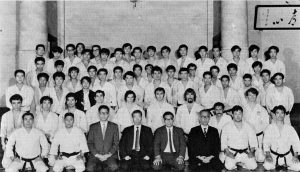
World Karate-do Championship in Tokyo, 1970 – Jon Beltram, 2nd row, 4th from left; Mr. Ohshima, front row, far right
In 1970, five SKA members -Jon Beltram, Don DePree, Jeffrey Klein, Ron Thom, and Henry Wilkerson -were honored by being selected to the United States team representing America in the World Karatedo Championships held in Tokyo, Japan. Jon was appointed team captain. Their outstanding performance enhanced the international reputation of Shotokan Karate of America. Jon had some wonderful experiences and was able to practice with some of the modern legends of karate including Kamata Watanabe and Shigeru Egami.
“Mr. Ohshima took the five of us and a French guy to Mr. Egami’s home. Mr. Egami entertained us with tea and some small finger food. He began to talk to us about ‘intrinsic energy’ and the ability to hold or stop an opponent using intrinsic energy. He brought in one of his students, and had him attack. Egami would just extend his arms, and the student would stop. Don DePree looked at me, and I looked at Don, and we both just kind of raised our eyebrows in a kind of skeptical way like, ‘Oh, SURE!’ I think Egami caught the exchange, because he asked me to get up and attack him. So I got up and got in my stance which at that time was kind of a back cat stance, and I was going to just jump in and give this old man a punch in the head. I mean, that was my mentality at the time. So, just at the moment when I was just starting to move, he kind of reached toward me, palms out, and it was just like a breath of air. I’ve never been able to explain this to anybody. It was just like a warm, firm, almost sticky feeling. He was five feet away from me and never touched me, but I was unable to attack. What was really interesting about it was that it was just at that moment when I had released. I had already committed myself to go, and was just starting, and it was just a very strange feeling.”
After Jon returned home, one of his juniors, David L. Mills, then a san-kyu, started a group at Longview Community College under Jon’s supervision. That group is still active over twenty-five years later!
The first Midwest summer special training was in 1975 at Champaign/Urbana, Illinois. For the next ten years, Mr. Ohshima led all the Midwest special trainings. He retired in 1984, after he had completed his 100th special training.
In 1977, Jon was awarded the MS degree in education from the University of Kansas.
In 1978, David Lightner, then a nidan, started a dojo in Lawrence, Kansas at the University of Kansas. It was active until 1983.
The Kansas City dojo moved in 1984 to the Shawnee Community Center. Summers and winters there were awful, and conditions in the building were ‘spartan.’ It was sweltering in the summer, and so cold in the winter that sometimes the water, which always stood in the corner of the room, would be frozen. Kumite there was often more like ice hockey!
Summer special training in Champaign/Urbana, Illinois in 1985 was the first special training Jon Beltram led. He continued to lead both summer and spring trainings each year until his retirement after summer special training in 1995.
Jon Beltram and Jim Kaplafka were elected to the SKA board of directors in February of 1986. Both continue to serve and attend the annual meetings of the board each February.
- David Lightner at Wentworth special training, 1977
- 1977 group at St Ann’s dojo
- 1978 Kelly Rudolph, Jon Beltram, David A Mills, Dan Lobmire, Greg Barstow at Lexington, MO special training
- 1982 David Lightner, Earl Rand, David A Mills, Jon Beltram, Greg Barstow, Dan Lobmire, Donnie Duncan
- 1982 Jon Beltram breaking
- 1984, Shawnee Community Center group (front) Donnie Duncan, Jon Beltram, Greg Barstow, Lynn Durbin. Back row: John Bixby, Terry Murphy, unidentified, Andy Brown, Carl Johnson
Early in 1986, the dojo moved to Beller’s Dance Studio in Overland Park, Kansas. It was much more comfortable at Beller’s due to adequate heating and air conditioning, but there were several columns in the middle of the dojo. We had to wrap them with thick foam and tape for protection during kumite. That year marked the first spring special training in Kansas City.
Carl Johnson, then a shodan, received a scholarship (along with Bill Kreda from the University of Northern Illinois) from the Midwest region to compete in the annual Nisei Week Exhibition and Tournament in Los Angeles, California. He faced a sandan in his first match, was eliminated in short order and returned home with impressive bruises all over his ribs. Those bruises were exactly in the shape of his opponent’s knuckles. “Boy, those West Coast guys hit hard!” was almost all he had to say, but it was apparent that he’d had a good experience, and Mr. Ohshima had taken him to a wonderful dinner. Everyone in Kansas City was very proud of him.
From late 1986 until 1996, the dojo was located at Body Trends in Westwood, Kansas.
In May, 1988, Mr. Ohshima visited for a wonderful weekend of karate practices and parties. The black belts met Mr. Ohshima at the airport, along with a limousine contributed by Rod Porter. We all met later for dinner at Jun’s Japanese Restaurant. We had a great time, but it was clear that Mr. Ohshima would have preferred some other kind of food. Prior to Mr. Ohshima’s visit, Jon Beltram, David Lightner, and Mike Lyon had discussed the idea of video taping our practices with Mr. Ohshima and then producing a video to raise money for the Dojo Building Fund. Jon asked Mr. Ohshima’s permission Saturday morning before practice, and Mr. Ohshima agreed to the practice tape as well as several other video ideas Jon had. David gave up his practice to operate the camera. We had a wonderful practice Saturday, followed by dinner at the Kansas City Club. We practiced again Sunday morning, and we bid Mr. Ohshima a fond farewell that afternoon.
- 1988 group from practice with Ohshima Sensei at Susie Brown’s Body Trends
- 1988 Ohshima Sensei demonstrates good posture with David A Mills
Between May and September, the group produced three video tapes, A Practice with Ohshima Sensei, May, 1988, Highlights of the 1976 20th Anniversary Celebration which contained Mr. Ohshima demonstrating nage-waza and performing the kata Hangetsu among other wonderful stuff, and Jon Be/tram’s Self Defense Techniques, in which Jon demonstrated how to defend against various attackers and various weapons. The unfortunate attackers were Donnie Duncan, Mike Lyon, and David A Mills. David Lightner did all the camera work and editing, Jon Beltram was the talent, and Mike Lyon spent years marketing the tapes to SKA members. Over 1,000 tapes were sold and over $20,000 raised for the Dojo Building Fund.
After the June, 1988 special training in Champaign/Urbana, Mr. Ohshima appointed Mike Lyon manager of the Midwest region for SKA.
In the fall of 1988, Mike Lyon started a dojo at the Kansas City Art Institute, where he had earned a degree in painting in 1975. That dojo is still very active and has produced a black belt, Val Barnett.
In June of 1989, the first annual Nisei Week preliminary tournament was held in Kansas City to select two competitors from KC to represent the Midwest at the annual Nisei Week Demonstration and Tournament in Los Angeles. Kelly Rudolph, Donnie Duncan, and David Lightner were chosen along with members from Illinois. Jon helped judge the tournament. Mike Lyon was asked to fill a vacancy on the East Coast team and wound up winning a medal in team competition.
John Rogers started the South Kansas City dojo in 1989 which remained active until 1992.
Jon had been working on his doctorate for five years at the University of Kansas. In 1989, he was finally awarded the EdD in Administrative Education. His dissertation was an evaluation of software for the use of secondary school administration.
Jon’s juniors threw a big party in celebration of his doctorate and in honor of his thirty years of karate practice. About fifty people attended, and Jon was presented with a plaque inscribed with the names of the thirty-three black belts he had trained at the time. Dinner, dancing, many testimonials, and a wonderful celebration!
In 1990, Mr. Ohshima visited for another weekend of practices, sightseeing, and eating. Practices were held at the Body Trends dojo and at Longview.
In 1990, Lee and George Boje started the Merriam, Kansas dojo, which is still active.
Donnie Duncan began to lead practices two days a week at the Kansas City dojo.
- Donnie Duncan competes at Nisei Week, 1990
- Carl Johnson competes against a French team member at Harmony 1990
In August of 1990, Jon Beltram, Donnie Duncan, Carl Johnson, Patty Richardson, Mike Lyon, David Lightner, and David Altman attended the special world wide Shotokan gathering called Harmony 1990 in Santa Barbara. Carl competed in the tournament (which all remember as one of the roughest in history) and was disqualified after knocking out his big French opponent twice with haito (ridge hand) techniques. David Lightner volunteered his services as videographer for the taping of Harmony 1990 and did a wonderful job. All enjoyed the practices (900 Shotokan black belts?!), camaraderie, and fantastic evening entertainment.
In 1991, John Rogers and Andy Brown started a dojo at the Ford plant in Claycomo, Missouri, which remained active about a year.
In the summer of 1991, Donnie Duncan passed the yodan examination. He is currently the most senior of Jon’s students.
In October of 1991, several members of Kansas City Shotokan traveled to Chicago to compete in the annual tournament hosted by the Downtown Chicago dojo and judged by Sadaharu Honda, Jon Beltram, and Dominick Pizoli. There were about forty competitors that year, and the Kansas City representatives brought top honors to their dojo. Carl Johnson placed first in black belt jiyu-kumite and suffered three broken ribs in the contest. Mike Lyon placed first in black belt kata with a performance of Heian Nidan. Heather Cornelius, one of Mike’s students at the KCAi dojo, placed second in white belt jiyu-kumite, triumphing over a dozen or so men.
November of 1991, Carl Johnson, Mike Lyon, and David Lightner from Kansas City joined Mr. Ohshima and about thirty other SKA members for a two week visit to Japan and to attend the sixtieth anniversary celebration of the Waseda University Karate Club. The sight-seeing was excellent, the food exotic and wonderful, and the accommodations were fantastic. Mike and David were honored to perform jiyu-ippon kumite before a large audience of senior members of the Waseda Club, and Carl Johnson was selected by Mr. Ohshima to be part of the SKA team in competition against the Waseda team.
Don DePree, godan and SKA’s executive vice-president led some wonderful practices in Kansas City one weekend in 1992. He concentrated on fundamentals of jiyu-kumite, ippon kumite, and held a special clinic for seniors in tournament judging and protocol. Don also enjoyed a huge lunch at Gates Bar-B-Q. Everyone was impressed with Don’s tremendous reverse punch.
- Cozumel, Mexico, 1992
- Ready for SCUBA in Cozumel, Mexico, 1993
A large group from the KC dojo travelled together along with Pat Brown, the official dojo tour guide, on the first of several dojo vacations. This one was to Cozumel, Mexico where almost everybody went SCUBA diving through the fantastic coral reefs. If you missed it, obtain a copy of Bad Boys Go to Cozumel, Volume One, the video, from Eric Manuel or Andy Brown.
Sada Honda, godan and president of SKA’s black belt council visited in the fall of 1992. He led us through several fantastic practices, taught us the ‘flopping fish’ exercise, and seemed to deeply enjoy the close comradeship of the Kansas City group, as well as the great steaks at Jess ‘n Jim’s Country Steak House. We were very lucky to be able to practice with Mr. Honda. He focused on breathing from tanden, energy flow from breathing, and ultra-slow-motion kata. It was great!
In 1993, Greg Barstow started the Basehor, Kansas dojo, which became inactive early in 1996. Andy Brown has taken over instruction of some of the Basehor students with informal practices at the Kansas City Club.
John Teramoto, godan and vice-president of the BBC, accepted a teaching position at the University of Kansas and began making regular visits to the KC, Merriam, and Basehor dojos.
In 1994, Mike Lyon started a second dojo, this one at AT&T, and Greg Oliver assisted in teaching.
David Altman started the University of Nebraska dojo in Lincoln, Nebraska.
In 1995, Jon led his fiftieth special training and announced his retirement from special training leadership.
“The summer of 1995 was my fiftieth special training. These are some of my reflections:
“First and foremost, without special training, we would be just another group practicing the ancient art of karate. But because of special training, we are unique in our approach to this wondrous art. I, for one, feel that special training gives us an opportunity to see our strengths as well as our weaknesses. We are able to face our mental blocks clearly. Because of special training, we are better able to face the real adversities of our lives. We learn perseverance and focus of purpose (concentration), the will to survive, to never give up, to continue with our best effort until the very end.
“These attributes, after many repetitions, become part of our subconscious. Our control, both physical and mental, becomes much greater. Those who observe us after many years of training see our movement and our mental attributes as mystical or magical. Yet, we know that it is simply the result of ten thousand hours of repetition of rudimentary basics of mental and physical practices of masters, passed down to us over fifteen hundred years.
“Our practice is not much different than the process of making a fine sword. Through the hottest fire comes the strongest sword. Thus, our special training is the fire. We are the sword. Through the most severe of practices, we polish both our physical and mental skills until our very souls are fortified. Thus, we are better able to face life’s adversities.
“Master Funakoshi said, ‘Karate is life, and life is karate.’ Special training is a microcosm of life’s adversities. It allows us to face the adversities of life ( the macrocosm) with a clear mind. Thus, we place ourselves into special training to survive small adversity, so that we may face life’s real adversities and conquer them. To me, Friedrich Nietzsche’s saying completes the circle, ‘Those adversities that we survive can only make us stronger!e”‘
- Jon Beltram’s 50th special training, June, 1995
In the spring of 1996, Donnie Duncan led his first special training at the Barstow School in Kansas City.
In August, 1996, the Kansas City dojo location changed to the Cultural Arts Center in Prairie Village, Kansas.
Jon has been an educator for the Shawnee Mission School District for twenty-seven years. He teaches science and is an administrative assistant at Shawnee Mission West High School, which has about 1,800 students. Jon is solely responsible for all discipline in the school. In that capacity, he works with parents, students, and teachers everyday. He specializes in the education of at-risk students. Recently, he developed the district’s ‘School Within a School’ for at-risk students and is currently in charge of that program.
Forty-one of Jon’s juniors (and their juniors) have attained black belt level. Many of those who continue the practice today were beginners ten, fifteen, twenty or more years ago, and there is a special closeness among these people who have practiced hard together over so many years.
“There’s a tremendous camaraderie among the people I’ve met through the long path. The people I’ve trained have become my extended family. It’s a life long relationship. Karate’s been the number one most important thing in my life for thirty-seven years. It’s been the focal point for any success I’ve ever attained. I think I was very scattered in my thoughts before karate. It’s the first thing I think of in the morning and the last thing at night.
“As a young karate-ka, I focused on the physical aspects of karate. If I have anything to say to junior members, it would be to focus on the mental practice of karate, the concentration, the focus of purpose. Mr. Ohshima says it best, ‘Less is more.’ When we try to physically push ourselves, our mind is focused on trying to push ourselves, it is preoccupied with that aspect of practice. The true practice is to let the mind go. To be completely clear minded. To have the feeling of mental freedom to just practice. Not to focus mentally, not to try hard, but to just do it, to just do it.
“The mind leads the body. If the mind is clear, focus and concentration become much stronger. When the mind focuses, the body follows. So when we concentrate less on the idea that we have to practice hard, less telling ourselves we have to practice hard, and just do it, we let the mind be free and clear, and let the mind direct the practice, not the physical.”

